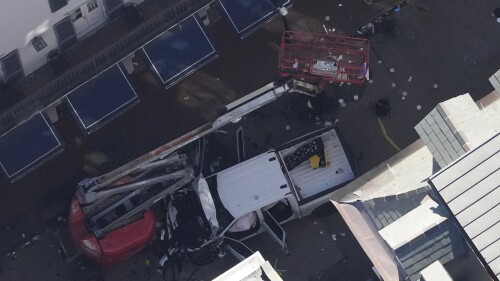Editor’s note: A pick-up driver, “hell-bent on carnage” drove into a crowd of pedestrians in New Orleans French Quarter on January 1, 2025. Police killed the driver in a firefight after the driver left the vehicle. The incident killed 10 people and injured 30.
This article by Richard Fairburn, originally published February 14, 2017, was written after a series of vehicle ramming attacks on pedestrians, a tragic trend that has continued in the ensuing years. Recently, a suspect drove into a Christmas Market in Germany, killing 5 and injuring more than 200.
Use these vehicle attack incidents as an opportunity to review your department’s policies and protocols for protecting crowded mass gatherings and firing at a vehicle and driver attacking a crowd.
The New Orleans Police Department’s Use of Force chapter lists “Shooting at or from moving vehicles” as a prohibited action. It specifically states:
Original article
How can a vehicle be used in a vicious attack, terroristic or otherwise? The worst case is a vehicle-borne improvised explosive device, commonly referred to as a VBIED. The U.S. witnessed this type of event when Timothy McVey attacked the Alfred P. Murrah Federal Building in Oklahoma City using a Ryder truck loaded with an estimated 4,800 pounds of ANFO explosives.
VBIEDs are the most common weapon used against our troops in the Global War on Terror. Anything from a small car to a truck packed with military-grade explosives, like artillery shells, can be detonated by a suicide driver or remotely by a cell phone.
Even without the addition of explosives, a vehicle remains a massive impact weapon. In 2016, large cargo trucks were used to attack innocents in Nice, France and Berlin, Germany, resulting in 98 deaths and almost 500 injuries. A year before that, a car was deliberately driven onto a crowded Las Vegas sidewalk in which one person was killed and more than 30 were injured.
Many times each year, U.S. police officers are attacked by cars driven deliberately at them, resulting in injuries and sometimes death.
Defense against vehicle attacks
In many police encounters a vehicle can be used as a weapon of opportunity. Fixed locations can be protected by bollards, short barrier posts extending many feet into the ground or bedrock. Concrete Jersey Barriers (sometimes called K-rails on the West Coast) and large parked vehicles loaded with sand or gravel can serve as portable protection for temporary locales, like the Christmas market in Berlin or recently for the Inaugural festivities in Washington D.C.
Tire deflation devices can also be used as permanent or temporary deterrents, but they are unlikely to stop a large vehicle that has already built momentum. Firearms can be used to deflate tires, but rarely blow tires like we see in the movies. Instead, bullet holes tend to deflate tires slowly, and the projectiles pose threats to other officers and innocent bystanders.
Killing an attacking driver with gunfire may not affect the vehicle’s trajectory. Still, the driver’s demise may get pressure off the accelerator or cause the vehicle to veer away from the primary target.
Policy concerns with motor vehicle attacks
This brings us to the growing impetus of police policy makers seeking to prohibit the use of gunfire from or at vehicles. Such policy is best structured around the legal or moral justification of using deadly force, not the specifics of application. In other words, administrators who prohibit their officers from firing at or from a vehicle are tying their hands from possible life-saving solutions.
Some administrators create such policies because they fear that officers may deliberately step into harm’s way, willingly exposing themselves to a moving vehicle threat, in order to justify their use of deadly force. This is unlikely.
Arguing policy concerns
Several years ago an officer from my agency was backing up a highway patrol officer pursuing a drunk driver on a foggy and snowy night. The resulting crash ended up with both officers on foot with the suspect attempting to run over the highway patrolman. A couple of tires were shot out during the low-speed, skidding-in-the-snow event, to no effect.
The officer eventually decided the threat against the highway patrol officer was serious enough to justify deadly force, but the highly mobile event didn’t allow him a clear shot at the driver without also endangering the other officer. So, the officer emptied his Beretta 92 into the engine compartment while jogging alongside. One 9mm bullet severed the alternator wires and another knocked out the fuel pump, eventually killing the 1969 Barracuda and stopping the attack. At the time, the departmental policy prohibited firing at/from a vehicle, but the shooting review board ruled his actions justified. Still, killing a car with any small arms fire is strictly a matter of luck.
An object in motion tends to remain in motion. If a vehicle builds up a head of steam, only a bollard, Jersey barrier or loaded truck will stop it.
A couple of years ago, two Louisiana troopers were rolling to back up a deputy sheriff on a traffic stop. As they arrived, the deputy was in a fight for his life, as his attacker got control of the officer’s sidearm. While the shotgun-side trooper tried to free himself from the seatbelt and exit the vehicle for a shot, the driver trooper simply drew and killed the attacker with several shots through the windshield of his own patrol car.
When preparing for vehicular attacks, remember Newton’s first law of motion:
Vehicles appear to be the next thing for terrorist attacks, and our options for dealing with the threat are limited.





